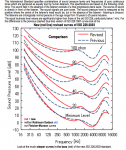Re: Perception of volume change at higher/lower levels
This is a very interesting question and we do have some objective evidence to answer it. Looking at equal loudness curves (red) we can indirectly compare the dependence of perceived loudness on measured SPL at different frequencies.
See the equal loudness curves in this graph:
Fletcher
The intention of the FM and equal loudness curves is to compare perceived loudness of a fixed SPL at different frequencies, but the curves also give us information on the differences between perceived loudness and measured SPL at different fixed frequencies. The red lines are equal loudness contours and the vertical distances between adjacent red lines can be interpreted as the differences in perceived loudness of the 2 sounds at that frequency. For example the red line that is 80 dB SPL at 1 kHz is perceived as 80 phons at 1 kHz, 10 kHz, and 100 Hz, although it takes about 92 dB SPL at 10 kHz and 91 dB SPL at 100 Hz to be perceived as 80 phons.
To get an answer to your question from that graph, look at the vertical distances between the 80 and 100 phon lines and between the 40 and 60 phon lines. The differences in perceived loudness are, by definition, 20 dB for each comparison (differences in phons are measured in dB). At 1 kHz the differences in dB SPL (vertical distances between the red lines) are just about exactly 20 dB for both the 40-60 and 80-100 comparisions. Reading off the red (dotted) lines, at 10 kHz, the differences are about 18 dB for the 40-60 and about 21 dB for the 80-100. So at 10 kHz, an 18 dB change from 55 to 73 dB SPL will be perceived as a 20 dB change, as will a 21 dB change from 93 to 104 dB SPL. At 100 Hz, a 15 dB change from 63 to 78 dB SPL will be perceived as a 20 dB change, as will a 15 dB change from 91 to 106 dB SPL. At 20 Hz, a 12 dB change from 89 to 101 dB SPL will be perceived as a 20 dB change, as will a 7 dB change from 101 to 108 dB SPL, or a 10 dB change from 108 to 118 dB SPL, or a 10 dB change from or 118 to 128 dB SPL.
So, based on these data, it seems that there is not much difference in how big the perceived change in loudness will be for softer and louder sounds, except at very high or very low frequencies. At high frequencies, there is a tendency toward perceiving a 20 dB increase less noticeably at higher SPLs compared with lower SPLs, but it is not a very strong effect. At 10 kHz, an 18 dB change at lower SPL will be perceived similarly to a 21 dB change at higher SPL. At low frequencies, it is not a consistent effect in one direction or the other. In the main audible frequency range there is really no noticeable difference. The data do not necessarily extrapolate to painfully high SPLs to address what Per has observed empirically.
Clearly, a given dB SPL is perceived as softer at both low and high frequency extremes, and the changes in loudness are perceived to be smaller at low frequencies, but I think the answer to your question is that the perceived change in loudness is at most weakly dependent on the measured SPL, really only noticeable at frequency extremes. The usual caveat applies that psychoacoustic studies like the equal loudness contours involve averages over groups of volunteer participants and can predict general trends well, but not necessarily the experience of a given individual.
The more likely explanation for what your client observed is nonlinearity in the attenuation of gain at different gain levels, this is probably not a psychoacoustic effect.

